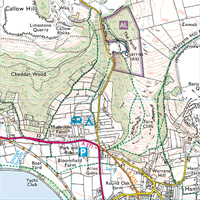Mapping

Reproduced by kind permission of the Ordnance Survey. MC 99/91
Useful Links
Downloadable Guides
![]() Grid References - 6 Figure & Bearings
Grid References - 6 Figure & Bearings
![]() Map Sign Flashcard set (Symbols and real life images)
Map Sign Flashcard set (Symbols and real life images)
![]() Map Symbol Bingo (A4) by Graham Williams, 12th Andover West
Map Symbol Bingo (A4) by Graham Williams, 12th Andover West
![]() Map Symbol Bingo (A3) by Graham Williams, 12th Andover West
Map Symbol Bingo (A3) by Graham Williams, 12th Andover West
![]() Map Ready Reckoner by Graham Williams, 12th Andover West
Map Ready Reckoner by Graham Williams, 12th Andover West
Introduction
The ability to use a map correctly is an important scouting skill. If you intend to go hill-walking or hiking then it becomes an important skill in its own right. Getting lost when the weather begins to take a turn for the worst is not the best experience in the world (and I know that firsthand!). If you are walking in potentially 'dangerous' country then it is paramount for safety that you know where you are and where you are going.
In this section we cover the main points involved in becoming familiar with a map and all the information that it contains. Note that related material, (Compass and Direction Finding) are also important but these are covered in their own section.

Aqua 3 Maps
Weatherproof, Tough & Durable, Anti-glare, Write on/Wipe off, Lightweight AQUA3®
Free Post & Pack
Aqua 3 sell special all weather maps. These are coated with a special waterproof material and prove to be very useful in the poorest of weathers.

Get 10% off all Ordnance Survey Maps and free UK Postage & Packaging on all OS Maps orders
Maps
Note that the word 'map' covers a multitude of sins. There are many different types of maps. Some merely differ in scale or orientation, others differ greatly in what they intend to show.

Thank you to Ordnance Survey for giving permission to reproduce their map keys and map extracts
For example a simple tourist town map is designed to show where the local points of interest and attractions are. If you want to use it to locate the highest ground in the area you will be in trouble.
Orienteering maps often have their own scale and symbols and their own way of showing information. An Ordnance Survey map may mark out areas of forest but the orienteer may well wish to know how dense that wood is, how long it will take to cross. Simply marking a boundary on the map may be of no use if you find it is a 20 ft high wall with barbed wire on top when you were expecting to hop over it!
Maps differ in detail and scale from country to country and indeed often from region to region.
Always ensure that you have a suitable map, of a scale and design that you are familiar with and which serves your current use. Taking a tourist map on a hike up in the mountains will surely lead to trouble while trying to find the local tube station on a detailed forestry map will be equally as challenging!
Once you have your map make sure it is protected. I would suggest that you never write on the map itself, not even in pencil. There are many map cases on the market that can keep your map clean and dry. Failing that you can simple cover your map in clear plastic or even keep it in a clear plastic bag. Look after your map. Fold it carefully (maps that are often used can develop tears or wear at the folds. You could try folding the map in a different way occasionally although I find the best method is simply to replace the map every so often and use the old one as a training map). With a clear plastic cover you can 'mark' the map by drawing on it with a chinagraph pencil or even a felt tip pen (make sure you can rub it off with ease).